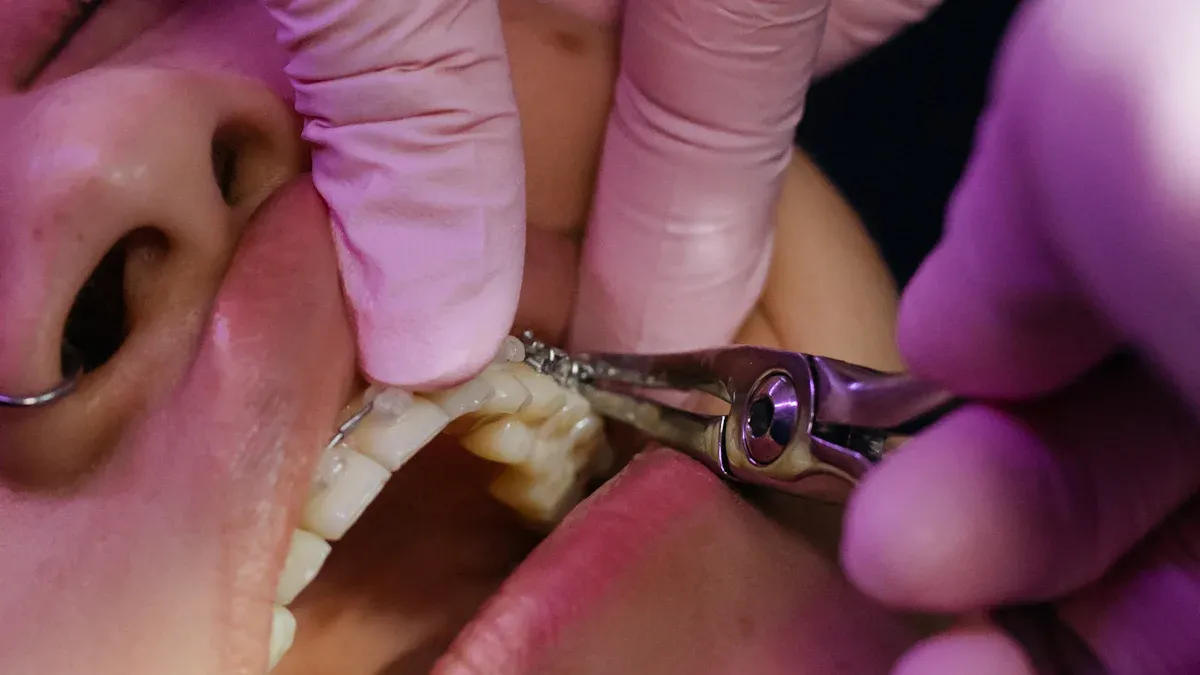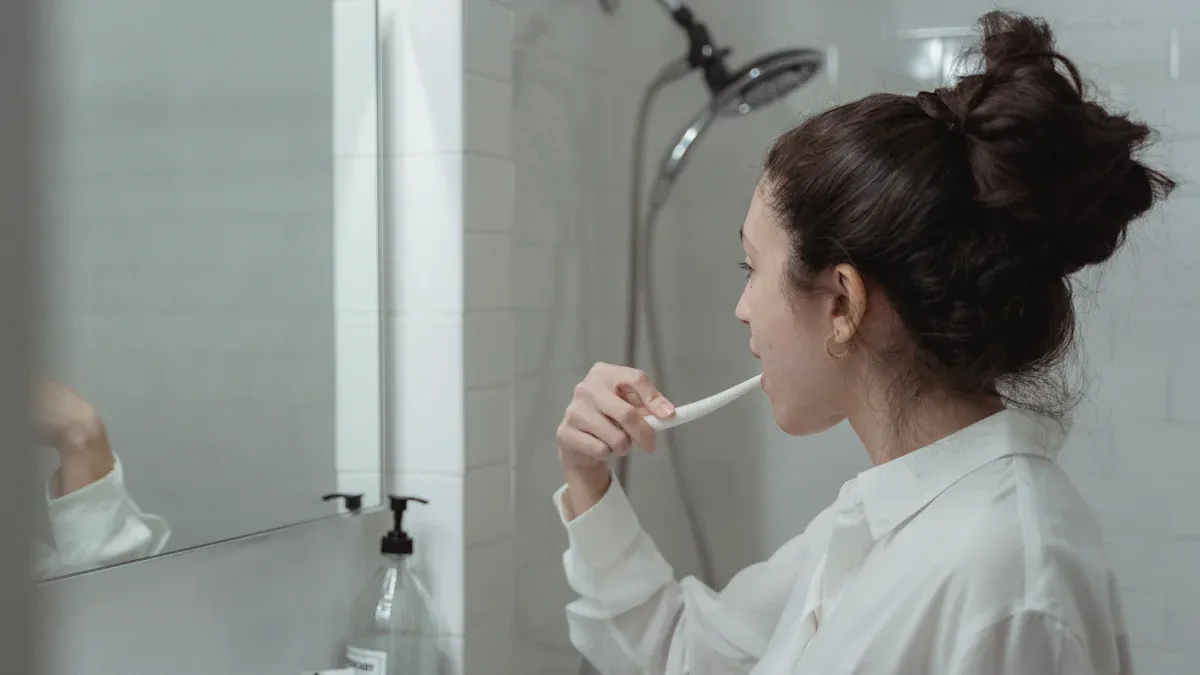You might wonder if daily brushing can truly help with allergies. In fact, research suggests that brushing reduce allergies by removing common allergens from your surroundings—whether you’re brushing your teeth, hair, skin, or even your pet. For instance, studies indicate that brushing with a special toothpaste may support allergy management, and brushing pets can significantly reduce pet dander in your home.
| Study Title | Findings | Methodology |
|---|---|---|
| A Brush with Success | Patients showed increased adherence to oral mucosal immunotherapy through brushing, leading to better allergy management. | Survey of patients regarding satisfaction with different immunotherapy delivery methods. |
| A new toothpaste could help adults with peanut allergies | The specially designed toothpaste may help desensitize individuals to peanut allergens over time. | Study on the effects of brushing with a peanut protein-infused toothpaste on immune response. |
How Brushing Reduce Allergies

Oral Brushing and Allergies
You can help manage allergy symptoms by keeping your mouth clean. When you brush your teeth every day, you remove food particles and bacteria that may trigger allergies. Good oral hygiene supports a healthy balance of bacteria in your mouth. Studies show that people with poor oral health often have more allergy symptoms, such as sneezing, itchy eyes, and runny nose. You may also notice that brushing reduce allergies by lowering inflammation in your body.
Tip: Brushing with toothpaste that contains special ingredients, like probiotics or even peanut proteins, may help your body get used to certain allergens. Some clinical trials found that people using these toothpastes had fewer allergy symptoms over time.
Here is a table that shows some findings from clinical trials about oral hygiene and allergies:
| Finding | Description |
|---|---|
| Oral Probiotic Deficiency | Identified as a cause of allergic rhinitis |
| Effectiveness of AllerPops | Provided sustained allergy relief (p = 0.002) |
| Correlation with Probiotics | Significant changes in Fusobacteria (R = 0.32, p = 0.009), Butyrivibrio (R = 0.25, p = 0.044), and Peptostreptococcus (R = 0.34, p = 0.005) |
| Registration | Clinical trial registered under NCT05956691 on July 20, 2023 |
When you brush your teeth, you help keep your mouth healthy and may notice fewer allergy symptoms. Brushing reduce allergies by stopping harmful bacteria from growing and lowering the chance of inflammation.
Pet Brushing Benefits
If you have a pet, you know that fur and dander can make allergy symptoms worse. Brushing your pet often helps remove loose fur and dander before it spreads around your home. When you brush your pet outside, you keep most of the dander out of your living space. This simple step can make a big difference in how you feel every day.
Regular grooming is important for reducing the amount of dander your pet sheds.
Frequent brushing, especially outside, helps get rid of extra fur and dander.
Brushing reduce allergies by lowering the number of allergens in your home.
If possible, ask someone who does not have allergies to brush your pet. This keeps you from coming into contact with too much dander.
Bathing your pet too often can dry out their skin and actually increase dander, so focus on brushing instead.
You may find that brushing your pet every few days leads to fewer allergy symptoms. This routine helps you enjoy time with your pet without feeling uncomfortable.
Hair and Skin Brushing
Brushing your hair and skin can also help manage allergy symptoms. When you brush your hair, you remove pollen, dust, and other allergens that may have settled there during the day. This is especially helpful if you spend time outside. Brushing your skin with a soft brush, sometimes called dry brushing, can remove dead skin cells and prevent buildup that might trigger allergies.
Brushing reduce allergies by getting rid of allergens that stick to your hair and skin.
You can brush your hair before bed to keep allergens out of your pillow and sheets.
Dry brushing your skin once or twice a week can help keep your skin healthy and less likely to react to allergens.
You may notice that regular brushing leads to fewer allergy symptoms, such as itchy skin or sneezing. This simple habit can make your daily life more comfortable.
Types of Allergies Affected
Pet Allergies
If you have a pet, you may notice that pet dander causes many allergy symptoms. Pet dander comes from tiny flakes of skin, fur, and even saliva. When you brush your pet, you remove loose fur and dander before it spreads around your home. Regular brushing helps keep pet dander under control. You can see fewer allergy symptoms when you stick to a grooming routine. Recent research shows that brushing your pet often lowers allergen levels in your house. This means you and your pet can both feel more comfortable.
Regular grooming reduces shedding and pet dander in your home.
Brushing removes loose fur, dander, and debris, making your pet feel better and your home cleaner.
Consistent brushing helps eliminate pet dander, loose fur, and allergens, which leads to fewer allergy symptoms.
Pet dander, saliva, and urine can all trigger allergies like stuffy noses and itchy skin.
Keeping up with brushing is key to lowering pet dander and keeping your pet’s coat healthy.
You may find that brushing your pet outside helps keep pet dander from building up indoors. If you have allergies, ask someone else to brush your pet for you.
Dust and Pollen Allergies
Dust and pollen can stick to your hair, skin, and even your pet’s fur. When you brush your hair and skin, you remove these allergens before they cause problems. Brushing your pet also helps because dust and pollen can get trapped in their fur and mix with pet dander. If you brush your pet often, you lower the amount of pet dander and other allergens in your home. This can help you breathe easier and sneeze less.
Try brushing your hair and your pet’s fur after spending time outside. This simple step keeps dust, pollen, and pet dander from spreading to your furniture and bedding. You can also brush your pet before they come inside to stop pet dander and pollen at the door.
Skin Allergies
Skin allergies can happen when pet dander or other allergens touch your skin. Dry brushing your skin removes dead skin cells and dander, which helps prevent irritation. If you have sensitive skin, use a soft brush and gentle strokes. Brushing your pet also helps because it lowers the amount of pet dander in your home. Less pet dander means less chance for your skin to react.
Some people with food allergies may also react to pet dander if it carries traces of food. If your pet eats certain foods, their dander can pick up those proteins. Brushing your pet often helps remove dander and lowers the risk of skin reactions. You can also wash your hands after brushing your pet to avoid spreading pet dander.
Tip: If you have both food allergies and pet allergies, keep your pet clean and brush them regularly. This helps reduce pet dander and keeps your skin safe.
Brushing Techniques
Oral Care Tips
You can protect your mouth from allergens by choosing the right toothpaste and brushing method. Always use a soft-bristled brush and brush twice a day. Some toothpaste ingredients may cause allergic reactions. For example:
A child developed mouth sores and gum swelling after using toothpaste with SLS. The symptoms stopped after switching to an SLS-free toothpaste.
Cinnamon-flavored toothpaste sometimes causes tongue and lip swelling in children.
Parabens and sodium benzoate in toothpaste have led to oral rashes in some cases.
If you notice irritation, try a toothpaste without harsh chemicals or strong flavors. Rinse your mouth well after brushing. Replace your brush every three months to keep it clean.
Pet Grooming Tips
You can lower allergens in your home by grooming your pet often. Brush your pet outdoors to keep fur and dander from spreading inside. Regular brushing removes loose hair and allergens like pollen and dander. Try these tips:
Wipe your pet daily with a wet cloth to reduce allergens.
Use hypoallergenic grooming products, such as fragrance-free and dye-free shampoos, to avoid irritation.
Wash your pet’s bedding often.
Use a HEPA air cleaner to trap airborne allergens.
Vacuum regularly to pick up pet hair and dander from floors and furniture.
Ask a family member without allergies to help with grooming if possible. This keeps you from direct contact with allergens.
Hair and Skin Care
You can reduce allergy symptoms by caring for your hair and skin. Hair care products sometimes cause allergic reactions. Preservatives and fragrances in shampoos or conditioners may irritate your skin. Choose hypoallergenic products to lower your risk. Use gentle cleansers to remove dirt and allergens without drying your skin. Moisturize daily to prevent dryness and irritation. Always use sunscreen to protect your skin. Visit a dermatologist for regular check-ups if you have sensitive skin. Remember to brush your hair after being outside to remove pollen and dust. This simple step keeps allergens out of your home.
Risks and Limitations
Overbrushing Concerns
Brushing can help reduce allergens, but doing it too often may cause problems. If you brush your teeth, hair, skin, or pet too much, you might notice irritation or dryness. Overbrushing your pet can remove natural oils from their skin and coat. This can make their skin dry and itchy. You may also see more shedding or even small wounds on your pet’s skin. If you brush your own hair or skin too hard, you can damage the surface and make it more sensitive to allergens. You should always use gentle strokes and avoid brushing the same area over and over.
If you have allergies, you should work with an allergist to find the right balance for your brushing routine. An allergist can help you decide how often to brush your pet or yourself to avoid making symptoms worse.
Skin Irritation
Brushing can sometimes lead to skin problems, especially if you have sensitive skin or conditions like eczema or psoriasis. You may notice redness, dryness, or even a rash after brushing. The table below shows some common types of skin irritation caused by frequent brushing:
| Finding | Description |
|---|---|
| Oral Probiotic Deficiency | Identified as a cause of allergic rhinitis |
| Effectiveness of AllerPops | Provided sustained allergy relief (p = 0.002) |
| Correlation with Probiotics | Significant changes in Fusobacteria (R = 0.32, p = 0.009), Butyrivibrio (R = 0.25, p = 0.044), and Peptostreptococcus (R = 0.34, p = 0.005) |
| Registration | Clinical trial registered under NCT05956691 on July 20, 2023 |
If you have eczema, you should talk to your allergist before starting a brushing routine. Avoid brushing over inflamed or broken skin. Do not brush areas with rashes, wounds, or infections. People with eczema or psoriasis should be extra careful, as brushing can make these conditions worse. Always use a soft brush and moisturize your skin after brushing.
When Brushing May Not Help
Brushing does not solve every allergy problem. Sometimes, you may still have symptoms even with regular brushing. If you have severe allergies, you should see an allergist for more help. You may need other strategies to manage your symptoms. Here are some things you can try:
Use a humidifier to keep the air moist and help your nasal passages.
Rinse with salt water to clear allergens from your nose.
Choose allergy-friendly oral care products for sensitive gums.
Chew sugar-free gum to help with dry mouth.
Avoid known allergens by staying indoors on high pollen days and using air purifiers.
Take over-the-counter medicines like antihistamines or decongestants if needed.
Keep your home clean to lower indoor allergens.
If you have eczema or other skin conditions, brushing may not be the best option. You should always check with your allergist before starting new routines. Some people may need immunotherapy or other treatments to control allergic reactions.
Brushing in Daily Routine

Combining Brushing with Other Strategies
You can get the best results by combining brushing with other ways to control allergies. Brushing your teeth, hair, skin, and your pet helps remove allergens, but you can do more. Use air purifiers, wash bedding often, and keep windows closed during high pollen days. These steps work together to lower the number of allergens in your home.
Researchers have found that using different tools for brushing can help collect and remove proteins that cause allergies. The table below shows how well each tool works:
| Tool Used | Protein Collection (mg/mL) | Sensitivity (%) | Specificity (%) |
|---|---|---|---|
| Cytology Brush | 0.75 ± 0.45 | 75 | 86 |
| Dental Brush | 0.43 ± 0.24 | N/A | N/A |
| Nasal Curette | 0.071 ± 0.55 | N/A | N/A |
You can see that brushing with the right tool can help remove more allergens. When you brush your pet, you lower the amount of dander and fur in your home. This makes it easier to breathe and helps with managing your allergies. You can also wipe your pet with a damp cloth to catch even more allergens.
Tip: Try to brush your pet outside. This keeps fur and dander from spreading inside your house.
Creating a Routine
You can make brushing a habit by adding it to your daily schedule. Many people have found that a regular brushing routine helps reduce allergy symptoms. Some new toothpastes even mix in allergens to help your body get used to them. Here are some ways to build a routine:
Brush your pet every other day to keep dander low.
Use a special toothpaste each morning and night.
Brush your hair after coming inside, especially if you have a pet.
Dry brush your skin once or twice a week.
Wipe your pet with a wet cloth after walks.
Some people use a toothpaste that treats allergies by mixing in the allergen. Brushing with this toothpaste every day can make allergies less severe or even help them go away. You can see big changes when you stick to your routine. Your pet will feel better, and you will notice fewer allergy symptoms.
Note: If you have a pet, keeping up with brushing and other steps can make your home a safer place for everyone.
You can see that brushing plays a big role in allergy relief. When you brush your teeth, hair, skin, and your pet, you remove many allergens from your daily life. Keeping your pet clean and brushed helps lower pet dander and brings more relief at home. Try brushing your pet outside for even more relief. Add brushing to your routine, and you may notice less sneezing and more comfort. Small steps with your pet can lead to big changes in your allergy relief.
FAQ
Can brushing really help reduce allergy symptoms?
Yes, brushing can help lower allergy symptoms. You remove allergens like dust, dander, and pollen from your teeth, hair, skin, and pets. This makes your home cleaner and helps you feel better.
How often should I brush my pet to control allergies?
You should brush your pet every other day. Brushing outside works best. This routine keeps dander and loose fur from building up in your home. Your allergy symptoms may improve with regular grooming.
What type of brush should I use for dry brushing my skin?
Choose a soft-bristled brush. Hard bristles can irritate your skin. Use gentle strokes. Dry brushing once or twice a week works well for most people. Always moisturize your skin after brushing.
Can brushing replace allergy medicine?
Brushing helps reduce allergens, but it does not replace allergy medicine. You may still need medicine for strong symptoms. Talk to your doctor for the best plan.
Is it safe to use allergy toothpaste every day?
Most allergy toothpastes are safe for daily use. Always check the label for allergens or harsh chemicals. If you notice irritation, stop using the toothpaste and ask your dentist for advice.






